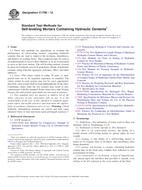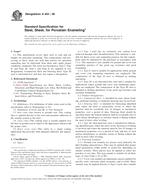1.1 These test methods cover the testing of industrial filament yarns made wholly of manufactured organic-base fibers, cords twisted from such yarns, fabrics woven from such cords, and products that are made specifically for use in the manufacture of pneumatic tires. They may be applied to similar yarns and cords used for reinforcing other rubber goods and for other industrial applications. The test methods apply to nylon, polyester, rayon, and aramid yarns and tire cords twisted from such yarns and to fabrics made from such cords. The yarn or cord may be wound on cones, tubes, bobbins, spools, or beams; may be woven into fabric; or may be in some other form. The methods include testing procedure only and include no specifications or tolerances.
1.2 No procedure is included for the determination of fatigue resistance of cord, but several commonly used procedures for the measurement of fatigue resistance of cords in rubber were published in the appendix of these test methods in the 1967 Annual Book of ASTM Standards, Part 24, and in earlier issues of Test Methods D 885.
1.3 The sections on “Growth of Conditioned Yarns and Cords,” “Properties of Yarns and Cords at Elevated Temperature,” and “Properties of Wet Yarns and Cords” have been moved to as non-mandatory informational items because of their very limited use by the industry and because precision and bias statements are not included.
1.4 This standard includes the following sections:
| Section | |
| Adhesion of Cord to Elastomers | 34 |
| Bibliography of Tire Cord Test Methods | X5 |
| Breaking Strength (Force) of Yarns and Cords at Elevated Tempera-ture | X2.3 |
| Breaking Strength (Force) of Conditioned Yarns and Cords | 16 |
| Breaking Strength (Force) of Oven-Dried Rayon Yarns and Cords | 23 |
| Breaking Strength (Force) of Rayon Yarns and Cords at SpecifiedMoisture Regain Level, Adjustment of | 17 |
| Breaking Tenacity of Conditioned Yarns and Cords | 18 |
| Breaking Tenacity of Oven-Dried Rayon Yarns and Cords | 24 |
| Breaking Toughness of Yarns and Cords | 28 |
| Commercial Mass | 9 |
| Conditioning | 7 |
| Contraction of Wet Yarns and Cords | X3 |
| Count of Tire Cord Fabric | 37 |
| Dip (Adhesive) Solids Pickup on Yarns and Cords | 33 |
| Elongation at Break of Conditioned Yarns and Cords | 19 |
| Elongation at Break of Oven-Dried Rayon Yarns and Cords | 25 |
| Elongation of Rayon Yarns and Cords at a Specified Moisture RegainLevel, Adjustment of Observed | 20 |
| Extractable Matter in Yarns and Cords | 32 |
| Force at Specified Elongation (FASE) of Conditioned Yarns andCords | 21 |
| Force at Specified Elongation (FASE) of Oven-Dried Rayon Yarns andCords | 26 |
| Growth of Conditioned Yarns and Cords | X1 |
| Identification of Fibers | 8 |
| Keywords | 40 |
| Linear Density | 11 |
| Mass of per Unit Area of Tire Cord Fabric | 36 |
| Modulus of Conditioned Yarns and Cords | 22 |
| Moisture Regain, Actual | 10 |
| Precision and Bias of Certain Yarn and Cord Tests | 39 |
| 35 to | |
| Properties of Tire Cord Fabric | 38 |
| Sampling | 6 |
| Shrinkage Force of Conditioned Yarns and Cords at Elevated Temperature | X2.5 |
| Shrinkage of Conditioned Yarns and Cords at Elevated Temperature | X2.4 |
| Significance and Use, General | 5 |
| Significance and Use, Tensile Properties | 14 |
| SI Calculations (examples for work-to-break, specific work-to-break,and breaking toughness) | X4 |
| Stiffness of Fabric | 38 |
| 12 to | |
| Tensile Properties of Yarns and Cords | 28 |
| Terminology | 3 |
| Thickness of Cords | 31 |
| Twist in Yarns and Cords | 30 |
| Width of Tire Cord Fabric | 35 |
| Work-to-Break of Yarns and Cords | 27 |
1.5 These test methods show the values in both SI and inch-pound units. SI units is the technically correct name for the system of metric units known as the International System of Units. Inch-pound units is the technically correct name for the customary units used in the United States. The values stated in either acceptable metric units or other units shall be regarded separately as standard. The values expressed in each system may not be exact equivalents; therefore, each system must be used independently of each other, without combining values in any way.
1.6 This standard does not purport to address all of the safety concerns, if any, associated with its use. It is the responsibility of the user of this standard to establish appropriate safety and health practices and determine the applicability of regulatory limitations prior to use.
Product Details
- Published:
- 04/10/2002
- Number of Pages:
- 32
- File Size:
- 1 file , 330 KB


